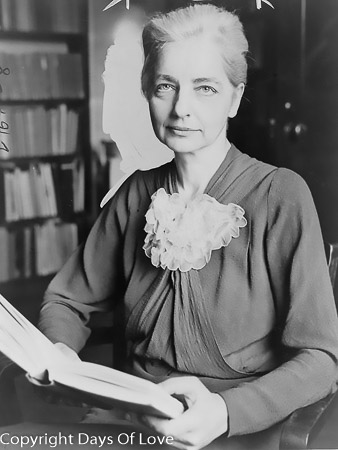

Queer Places:
Vassar College (Seven Sisters), 124 Raymond Ave, Poughkeepsie, NY 12604
The New School, 72 5th Ave, New York, NY 10011, Stati Uniti
Barnard College (Seven Sisters), 3009 Broadway, New York, NY 10027
Columbia University (Ivy League), 116th St and Broadway, New York, NY 10027
Mount Hope Cemetery, Norwich, New York 13815, Stati Uniti
 Ruth
Fulton Benedict (June 5, 1887 – September 17, 1948) was an American
anthropologist and folklorist.
Ruth
Fulton Benedict (June 5, 1887 – September 17, 1948) was an American
anthropologist and folklorist.
She was born in New York City, attended Vassar College and graduated in 1909. After studying anthropology at the New School of Social Research under Elsie Clews Parsons, she entered graduate studies at Columbia University in 1921, where she studied under Franz Boas. She received her PhD and joined the faculty in 1923. Margaret Mead, with whom she shared a romantic relationship,[1] and Marvin Opler, were among her students and colleagues.
Franz Boas, her teacher and mentor, has been called the father of American anthropology and his teachings and point of view are clearly evident in Benedict's work.
Benedict held the post of President of the American Anthropological Association and was also a prominent member of the American Folklore Society.[2] She became the first woman to be recognized as a prominent leader of a learned profession.[2] She can be viewed as a transitional figure in her field, redirecting both anthropology and folklore away from the limited confines of culture-trait diffusion studies and towards theories of performance as integral to the interpretation of culture. She studied the relationships between personality, art, language and culture, insisting that no trait existed in isolation or self-sufficiency, a theory which she championed in her 1934 Patterns of Culture.
Margaret Mead and Ruth Benedict are considered to be the two most influential and famous anthropologists of their time. One of the reasons Mead and Benedict got along well was because they both shared a passion for their work and they each felt a sense of pride at being a successful working woman during a time when this was uncommon.[16] They were known to critique each other's work frequently; they created a companionship that began through their work, but which also during the early period was of an erotic character.[17][18][19][20] Both Benedict and Mead wanted to dislodge stereotypes about women during their time period and show that working women can be successful even though working society was seen as a man's world.[21] In her memoir about her parents, With a Daughter's Eye, Margaret Mead's daughter implies that the relationship between Benedict and Mead was partly sexual. In 1946, Benedict received the Achievement Award from the American Association of University Women. After Benedict died of a heart attack in 1948, Mead kept the legacy of Benedict's work going by supervising projects that Benedict would have looked after, and editing and publishing notes from studies that Benedict had collected throughout her life.[20]
My published books: